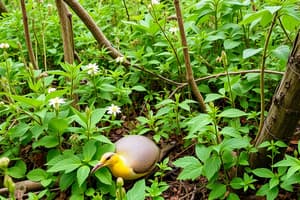Podcast
Questions and Answers
What must be present for natural selection to occur?
What must be present for natural selection to occur?
- Variation, competition, adaptations, and selections (correct)
- Sufficient resources for all organisms
- A fixed environment with no changes
- Uniform traits across a population
Which concept did Lamarck contribute to the understanding of evolution?
Which concept did Lamarck contribute to the understanding of evolution?
- Descent with modification
- Natural selection as a key process
- Survival of the fittest
- Inheritance of acquired characteristics (correct)
What does Darwin's theory of descent with modification suggest?
What does Darwin's theory of descent with modification suggest?
- All species continuously improve over time
- Species survive local conditions without progressive improvement (correct)
- Natural selection leads to progress in species
- Traits are fixed and do not vary in species
What observation did Darwin make about organisms in different regions?
What observation did Darwin make about organisms in different regions?
Which statement best represents the concept of artificial selection?
Which statement best represents the concept of artificial selection?
What role did finches play in Darwin's studies?
What role did finches play in Darwin's studies?
According to Darwin, what happens to individuals who are better suited to their local conditions?
According to Darwin, what happens to individuals who are better suited to their local conditions?
What is a common misconception about natural selection?
What is a common misconception about natural selection?
What is the definition of a dihybrid cross?
What is the definition of a dihybrid cross?
In autosomal dominant inheritance, what can be inferred if one of the offspring is affected?
In autosomal dominant inheritance, what can be inferred if one of the offspring is affected?
What characterizes incomplete dominance?
What characterizes incomplete dominance?
Which blood type has both A and B glycoproteins on red blood cells?
Which blood type has both A and B glycoproteins on red blood cells?
What distinguishes codominance from other patterns of inheritance?
What distinguishes codominance from other patterns of inheritance?
Which pattern of inheritance allows for a child to be affected while both parents are unaffected?
Which pattern of inheritance allows for a child to be affected while both parents are unaffected?
What significant observation did Darwin make about Galapagos species compared to South American mainland species?
What significant observation did Darwin make about Galapagos species compared to South American mainland species?
In a monohybrid cross, how many traits are being compared?
In a monohybrid cross, how many traits are being compared?
What is a key feature of transitional fossils?
What is a key feature of transitional fossils?
What is the primary use of a Punnett square in genetics?
What is the primary use of a Punnett square in genetics?
How do homologous structures differ from analogous structures?
How do homologous structures differ from analogous structures?
What does biogeography study primarily focus on?
What does biogeography study primarily focus on?
Which of the following best describes stabilizing selection?
Which of the following best describes stabilizing selection?
What provides evidence for common ancestry through DNA analysis?
What provides evidence for common ancestry through DNA analysis?
What role do vestigial structures play in understanding evolution?
What role do vestigial structures play in understanding evolution?
What does embryology reveal about animal evolution?
What does embryology reveal about animal evolution?
What structure separates the thoracic cavity from the abdominal cavity?
What structure separates the thoracic cavity from the abdominal cavity?
During inhalation, air moves into the lungs due to the difference in what?
During inhalation, air moves into the lungs due to the difference in what?
Which part of the respiratory system is responsible for trapping dust and bacteria in the air?
Which part of the respiratory system is responsible for trapping dust and bacteria in the air?
What occurs at the alveoli in the lungs?
What occurs at the alveoli in the lungs?
What effect does an increase in lung volume have on air pressure according to Boyle's Law?
What effect does an increase in lung volume have on air pressure according to Boyle's Law?
What causes asthma in the lungs?
What causes asthma in the lungs?
What is the primary role of the epiglottis during the respiratory process?
What is the primary role of the epiglottis during the respiratory process?
What is the function of cilia in the trachea?
What is the function of cilia in the trachea?
What triggers inflammation of the bronchi and bronchioles in asthma?
What triggers inflammation of the bronchi and bronchioles in asthma?
Which statement accurately describes chronic bronchitis?
Which statement accurately describes chronic bronchitis?
What role do capillaries play in the circulatory system?
What role do capillaries play in the circulatory system?
Which type of circulation involves the movement of blood from the heart to the body?
Which type of circulation involves the movement of blood from the heart to the body?
What is arteriosclerosis primarily characterized by?
What is arteriosclerosis primarily characterized by?
Which condition is primarily caused by smoking and can result in chronic bronchitis?
Which condition is primarily caused by smoking and can result in chronic bronchitis?
What is the primary function of veins in the circulatory system?
What is the primary function of veins in the circulatory system?
What typically characterizes a cough associated with bronchitis?
What typically characterizes a cough associated with bronchitis?
What defines an adaptation in the context of survival?
What defines an adaptation in the context of survival?
What differentiates Batesian mimicry from Müllerian mimicry?
What differentiates Batesian mimicry from Müllerian mimicry?
How did the coloration of the English peppered moth serve as an example of adaptation during the Industrial Revolution?
How did the coloration of the English peppered moth serve as an example of adaptation during the Industrial Revolution?
What was the major effect of the Clean-Air Legislation in the 1950s on the English peppered moth population?
What was the major effect of the Clean-Air Legislation in the 1950s on the English peppered moth population?
What is the primary difference between mutations and mutagens?
What is the primary difference between mutations and mutagens?
What best explains the outcome of variation among individuals in a species?
What best explains the outcome of variation among individuals in a species?
What is the significance of adaptation in relation to evolution?
What is the significance of adaptation in relation to evolution?
Which statement regarding the importance of variation in evolution is accurate?
Which statement regarding the importance of variation in evolution is accurate?
Flashcards
Monohybrid Cross
Monohybrid Cross
A cross of two individuals differing in one characteristic. For example, crossing a white-haired poodle with a black-haired Labrador.
Dihybrid Cross
Dihybrid Cross
A cross of two individuals differing in two characteristics. For example, crossing a white-haired poodle with a black-haired Labrador, but also considering another trait like curly vs. straight hair.
Autosomal Dominant
Autosomal Dominant
A condition where one allele completely masks the expression of the other allele, resulting in the dominant phenotype. An example is brown eyes being dominant over blue eyes.
Autosomal Recessive
Autosomal Recessive
Signup and view all the flashcards
Incomplete Dominance
Incomplete Dominance
Signup and view all the flashcards
Codominance
Codominance
Signup and view all the flashcards
Sex-Linked Inheritance
Sex-Linked Inheritance
Signup and view all the flashcards
X-Linked Recessive
X-Linked Recessive
Signup and view all the flashcards
Adaptation
Adaptation
Signup and view all the flashcards
Mimicry
Mimicry
Signup and view all the flashcards
Batesian Mimicry
Batesian Mimicry
Signup and view all the flashcards
Müllerian Mimicry
Müllerian Mimicry
Signup and view all the flashcards
Mutation
Mutation
Signup and view all the flashcards
Mutagens
Mutagens
Signup and view all the flashcards
Variation
Variation
Signup and view all the flashcards
Artificial Selection
Artificial Selection
Signup and view all the flashcards
Natural Selection
Natural Selection
Signup and view all the flashcards
How does natural selection work?
How does natural selection work?
Signup and view all the flashcards
Natural Selection is Situational
Natural Selection is Situational
Signup and view all the flashcards
Lamarck's Theory
Lamarck's Theory
Signup and view all the flashcards
Inheritance of Acquired Characteristics
Inheritance of Acquired Characteristics
Signup and view all the flashcards
Darwin's Theory of Evolution
Darwin's Theory of Evolution
Signup and view all the flashcards
Descent with Modification
Descent with Modification
Signup and view all the flashcards
Bronchitis
Bronchitis
Signup and view all the flashcards
Chronic Obstructive Pulmonary Disease (COPD)
Chronic Obstructive Pulmonary Disease (COPD)
Signup and view all the flashcards
Arteries
Arteries
Signup and view all the flashcards
Veins
Veins
Signup and view all the flashcards
Capillaries
Capillaries
Signup and view all the flashcards
Systemic Circulation
Systemic Circulation
Signup and view all the flashcards
Pulmonary Circulation
Pulmonary Circulation
Signup and view all the flashcards
Arteriosclerosis
Arteriosclerosis
Signup and view all the flashcards
What is the diaphragm?
What is the diaphragm?
Signup and view all the flashcards
How does air move in the lungs?
How does air move in the lungs?
Signup and view all the flashcards
What is the trachea?
What is the trachea?
Signup and view all the flashcards
What are alveoli?
What are alveoli?
Signup and view all the flashcards
What is gas exchange?
What is gas exchange?
Signup and view all the flashcards
What is asthma?
What is asthma?
Signup and view all the flashcards
What is COPD?
What is COPD?
Signup and view all the flashcards
What is the epiglottis?
What is the epiglottis?
Signup and view all the flashcards
Transitional Fossil
Transitional Fossil
Signup and view all the flashcards
Vestigial Structure
Vestigial Structure
Signup and view all the flashcards
Biogeography
Biogeography
Signup and view all the flashcards
Homologous Structures
Homologous Structures
Signup and view all the flashcards
Analogous Structures
Analogous Structures
Signup and view all the flashcards
Embryology
Embryology
Signup and view all the flashcards
DNA in Evolution
DNA in Evolution
Signup and view all the flashcards
Population Genetics
Population Genetics
Signup and view all the flashcards
Stabilizing Selection
Stabilizing Selection
Signup and view all the flashcards
Directional Selection
Directional Selection
Signup and view all the flashcards
Disruptive Selection
Disruptive Selection
Signup and view all the flashcards
Study Notes
Diversity Unit Review
- Binomial Nomenclature: The scientific name of a species, written in italics, with the genus name capitalized and the species name lowercase
- Morphological Species Concept: Defines species based on physical characteristics (e.g., body shape, size, features)
- Biological Species Concept: Defines species based on whether two organisms can produce fertile offspring
- Phylogenetic Species Concept: Defines species by their evolutionary history (phylogeny)
- Advantages of Morphological Species Concept: Simple, widely used, especially in plants.
- Disadvantages of Morphological Species Concept: Difficult to define acceptable variations in diverse populations, can't be applied to asexual or fossil species.
- Advantages of Biological Species Concept: Widely used and understood by scientists.
- Disadvantages of Biological Species Concept: Difficult to apply to geographically isolated populations, asexual organisms, or fossil species.
- Advantages of Phylogenetic Species Concept: Applies to extinct species, utilizes DNA analysis, aids in identifying new species.
- Disadvantages of Phylogenetic Species Concept: Evolutionary histories are not known for all species.
- Taxonomic Categories: Hierarchical classification system; Domain, Kingdom, Phylum, Class, Order, Family, Genus, Species.
- Dichotomous Key: A tool used to identify unknown organisms by posing a series of yes or no questions.
Prokaryotes vs. Eukaryotes
- Prokaryotes: Smaller (1-10 μm), circular DNA not bound by a membrane, single chromosome, asexual reproduction, unicellular, lack membrane-bound organelles, and many are anaerobic.
- Eukaryotes: Larger (100-1000 μm), DNA in a nucleus bounded by a membrane, several chromosomes, sexual and asexual reproduction, common multicellularity, possess membrane-bound organelles, and most are aerobic.
Virus Replication
- Lytic Cycle: Viruses quickly attach, enter, replicate, assemble, release, and kill the host cell in the process.
- Lysogenic Cycle: Viruses enter and attach their DNA (provirus) to the host's chromosomes. It may lie dormant and later reactivate, causing the lytic cycle.
Protists
- Mesophiles: Organisms that live in moderate environments.
- Extremophiles: Organisms that live in extreme environments.
- Binary Fission: A type of asexual reproduction in which a cell grows, duplicates its DNA, then divides into two genetically identical cells.
- Conjugation: A type of sexual reproduction where two cells link and exchange genetic material.
Multicellular Diversity
- Animals characteristics: Eukaryotic, multicellular, heterotrophic, mobile (most), reproduce sexually, have an embryo stage.
- Invertebrate: No backbone.
- Vertebrate: Backbone.
Cell Division and Reproduction
- Mitosis: A type of cell division that produces two identical diploid daughter cells from one diploid parent cell.
- Meiosis: A type of cell division that produces four genetically unique haploid gametes (sex cells) from one diploid parent cell.
Genetics
- Karyotype: A photograph of an organism's chromosomes. It is used to determine if there are any abnormalities in the number of chromosomes.
- Disorders: Downs (Trisomy 21), Edwards (Trisomy 18), Patau (Trisomy 13).
- Genetic Crosses: Monohybrid (one trait difference), Dihybrid (two trait difference), incomplete dominance, codominance.
Evolution
- Adaptation: A trait that helps an organism survive and reproduce in a particular environment.
- Mimicry: A structural adaptation in which a harmless species resembles a harmful species in coloration or structure. (Batesian/Müllerian)
- Mutations: Permanent changes in genetic material that introduce new alleles.
- Natural Selection: An evolutionary process whereby organisms with traits better suited to their environment tend to survive and reproduce at higher rates than other organisms in the population. This causes a change in allele frequency.
- Artificial Selection: When humans select desirable traits in organisms for breeding, leading to changes in the allele frequency.
Evolution and Speciation
- Factors that cause Evolutionary Changes: Mutation, Gene flow, non-random mating, genetic drift, and natural selection.
- Reproductive Isolating Mechanisms: Prezygotic (prevent mating or formation of a zygote) and postzygotic (prevent the development of a viable, fertile offspring).
Animal Diversity
- Digestive system: Parts and their role in digestion (Mouth, Stomach, Small Intestine)
- Enzymes: speed up chemical reactions, and are involved in digestion.
- Macromolecules (Carbohydrates, Proteins, Fats): Broken down into smaller units, with specific digestive enzymes.
- Respiration: Inhalation and exhalation, the mechanisms of breathing, and air pressure differences.
- Gas Exchange in alveoli.
Circulatory System
- Heart structure: Parts of the heart (atria, ventricles, valves)
- Blood vessels: Arteries, veins, capillaries Differences between systemic, pulmonary, cardiac circulation.
- Disorders: Atherosclerosis/Arteriosclerosis, high blood pressure.
- **Bypass surgery:**Surgical processes of replacing blocked arteries.
Plant Diversity
- Vascular vs. Meristematic Tissues: The roles and location.
- Parts of a leaf: Cuticle, epidermis, mesophyll (palisade, spongy), veins.
- Parts of the Flower: Stamen (male), pistil (female).
- Monocots vs. Dicots: Differences in flower parts, seed leaves, veins.
Studying That Suits You
Use AI to generate personalized quizzes and flashcards to suit your learning preferences.





